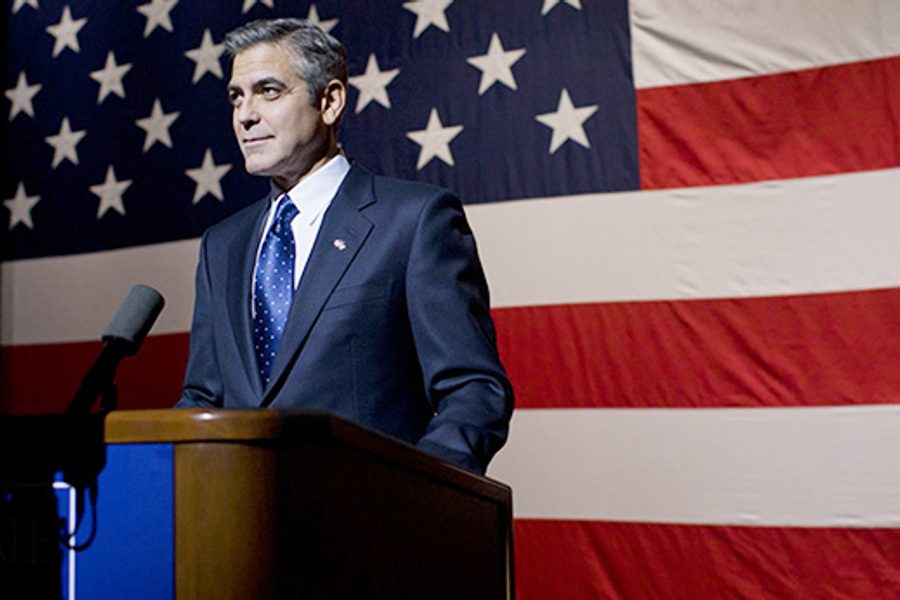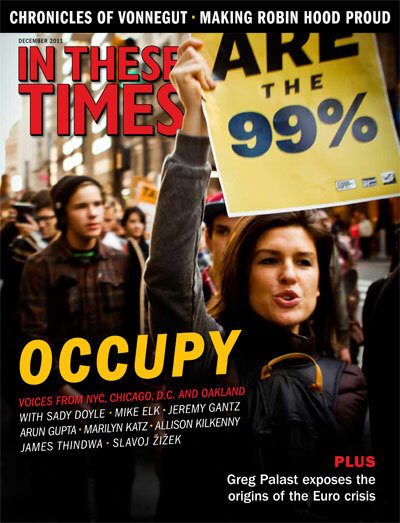George Clooney: The Man From Yesterday
Ides of March isn’t great, but at least its director and star actually cares about politics, history and memory.
Michael Atkinson

We should be very, very thankful that there is such a strange creature in the American mediascape as George Clooney. Not merely because many filmgoers deem him a good actor or a responsible progressive. He represents a far more precious resource: a serious celebrity figure swathed in the facts of history and memory. The Ides of March, 2011’s only for-grown-ups political exposé-drama, is certainly a blast from the past – a behind-the-scenes game of dirty political pool and corrupt king-making like we had in spades in the postwar years, starting with Gore Vidal’s play The Best Man (1960). The genre has more or less vanished–Wag the Dog (1997), Primary Colors (1998) and Bulworth (1998), all box-office fizzlers, were the last satiric shots at this kind of movie – as the dominant target audience for American movies skews ever lower and younger.
Clooney remembers another day and age, and Ides, which he also directed, co-wrote and co-produced, is a defiantly old-fashioned piece of work, reliant on idiosyncratic actors spewing smart dialogue, and structured around revelations and moral decisions, not fistfights, chases or even melodramatics. More than that, it’s a film that actually presupposes its audience’s interest in presidential campaign machinations, as if Clooney thinks that few real-world topics beyond sports and celebrity gossip interest us more. Truth be told, though, Ides is an oddly naive and simplistic tale, particularly when squared against what we know about real election-year skullduggery.
Politically, the film has little to say that we didn’t all say to each other in 1998; only an innocent high-schooler could be scandalized by the film’s depiction of backroom cynicism. But Ides also feels contained and small-boned, not so much an effort to dissect the dynamics of real-world politicking so much as to go at it within the comfortable confines of a ’50s – ’60s-style TV drama. Whether or not Clooney intended it, his film (based on a play by Beau Willimon) feels closer to an episode of Playhouse 90 than to 1972’s ultra-real The Candidate or Vidal’s masterpiece.
It’s hardly surprising, given Clooney’s career profile, which in almost every choice and echo is a passionate testament to postwar American culture. Seen this way, Ides has an auteurist sheen to it, the glow of the filmmaker’s stylized vision of the world. This way of seeing Clooney – imagine, a movie star with a theme! – occurred to me with The American (2010), or rather, the film’s bold, deliberately retro ad art that acutely evokes a poster for The Quiller Memorandum (1966).
Clooney is not Of the Present, but rather a deftly engineered manifestation of the ultracool past. Consider the neo-Sinatra heist films, the love of old-time broadcasting, the history-drenched political voyages, even rash experiments like Soderbergh’s The Good German (2006) and Clooney’s own Leatherheads (2008), both misdirected attempts at literally reincarnating Golden Age film genres. Everything about Clooney consciously evokes the day and age when he was a boy hanging with his dad in Midwestern TV station newsrooms.
What Clooney has to sell is, simply, maturity in a world of sugar-coated pubertal thrall. Maturity in both taste and priorities, and in the implicit connection to real history. Look at Clooney himself – there’s no mistaking him for a cute-teen-idol-turned-baby-faced-semi-adult, a la the Depps and Pitts of the world. This alone is something remarkable, and it’s not how it used to be: Going back to the ’30s, movie stars always seemed like fully grown, savvy, experienced adults, even when they were in their 20s. No one then or now would confuse Clark Gable or Humphrey Bogart for post-teen hunks, and neither would we, come the ’60s and ’70s, wonder when Sean Connery or Charles Bronson were going to start playing believable adults. Things began to change quickly with Star Wars and the Reagan administration, two successive forms of cultural infantilization. Suddenly, movie stars who would resemble teenagers well into their 40s gained eminence.
Not Clooney. He is for the rest of us, the under-targeted majority who do not spend days playing Halo and do not know or care to know who Ke$ha is. If Ides isn’t quite the political movie we need in the Obama era, it still has little competition – and Clooney himself has practically none.









